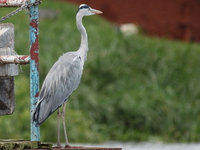herons
The Grey Heron, Ardea cinerea is a wading bird of the heron family Ardeidae, native throughout temperate Europe and Asia and also parts of Africa. It is resident in the milder south and west, but many birds retreat in winter from the ice in colder regions.
It is a large bird, standing 90-100 cm tall, with a 175-195 cm wingspan and a weight of 1-2 kg. Its plumage is largely grey above, and off-white below. Adults have a white head with a broad black supercilium and slender crest, while immatures have a dull grey head. It has a powerful pinkish-yellow bill, which is brighter in breeding adults. It has a slow flight, with its long neck retracted (S-shaped). This is characteristic of herons and bitterns, and distinguishes them from storks, cranes and spoonbills, which extend their necks.
The Goliath Heron (Ardea goliath) is a large wading bird of the heron family Ardeidae. It is found in sub-Saharan Africa, with smaller numbers in Southwest and South Asia.
This is the world's largest heron. The standing height averages over 1.4 m (4.5 ft), with a wingspan of at least 2 m (7 ft) and a weight of about 4 kg (9 lb). In flight it has a slow and rather ponderous look and, unlike some other herons, its legs are not held horizontally. Male and female look similar, with an overall covering of slate gray and chestnut feathers. The head and its bushy crest, face, back and sides of the neck are chestnut. The chin, throat, foreneck and upper breast are white, with black streaks across the foreneck and upper breast. The lower breast and belly are buff with black streaks. The upper mandible is black and the lores and orbital areas are yellow with a greenish tinge. The eyes are yellow and legs and feet are black. Juveniles look similar to the adults, but are paler.


